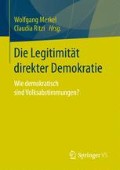Zusammenfassung
Kalifornien ist einer der 50 Bundesstaaten, die die Föderation der Vereinigten Staaten konstituieren. Damit genießt es zwar nicht den Status eines souveränen Staates, nutzt jedoch als ein großer und bevölkungreicher Staat innerhalb der USA häufig direktdemokratische Verfahren (Setälä und Schiller 2012). In Bezug auf Volksabstimmungen gilt Kalifornien im US-amerikanischen und im internationalen Vergleich als Vorreiter.
Access this chapter
Tax calculation will be finalised at checkout
Purchases are for personal use only
Preview
Unable to display preview. Download preview PDF.
Literatur
Abromeit, Heidrun. 2003. Nutzen und Risiken direktdemokratischer Instrumente. In Demokratisierung der Demokratie. Diagnosen und Reformvorschläge, hrsg. Claus Offe, 95-110. Frankfurt am Main: Campus.
Alexander, Robert M. 2002. Rolling the Dice with State Initiatives: Interest Group Involvement in Ballot Campaigns. Westport: Praeger.
Altman, David. 2011. Direct Democracy Worldwide. Cambridge, MA: Cambridge University Press.
Baldassare, Mark, Dean Bonner, Sonja Petek und Jui Shrestha. 2013. California’s Likely Voters. Online unter www.ppic.org/main/publication_show.asp?i=255, Zugriff am 13.12.2013.
Banducci, Susan. 1998. Direct Legislation: When Is It Used and When Does It Pass? In Citizens as Legislators: Direct Democracy in the United States, hrsg. Shaun Bowler, Todd Donovan und Caroline J Tolbert, 109-131. Columbus: Ohio State University Press.
Bowler, Shaun und Amihai Glazer. Hrsg. 2008. Direct Democracy’s Impact on American Political Institutions. Basingstoke/New York, NY: Palgrave Macmillan.
Cain, Bruce E. und Thad Kousser. 2004. Adapting to Term Limits: Recent Experiences and New Directions. San Francisco: Public Policy Institute of California.
California Proposition 98, Mandatory Education Spending. 1988. Ballotpedia.
California Secretary of State. 2015a. History of California Initiatives. Online unter www.sos.ca.gov/elections/ballot-measures/resources-and-historical-information/history-california-initiatives/, Zugriff am 14.03.2016.
California Secretary of State. 2015b. Recall History in California (1913 to Present). Online unter www.sos.ca.gov/elections/recalls/recall-history-california-1913-present/, Zugriff am 14.03.2016.
California Secretary of State. 2015c. Summary of Referendum Data. Online unter www.sos.ca.gov/elections/ballot-measures/referendum/, Zugriff am 14.03.2016.
Campbell, Ballard C. 1998. Tax Revolts and Political Change. Journal of Policy History 10 (1): 153-178.
Center for Governmental Studies. 2008. Democracy by Initiative: Shaping California’s Fourth Branch of Government. Los Angeles, CA: Center for Governmental Studies.
Citrin, Jack. 2009. Proposition 13 and the Transformation of California Government. California Journal of Politics and Policy 1 (1): 1-9.
Dubois, Philip L. und Floyd Feeney. 1998. Lawmaking by Initiative: Issues, Options and Comparisons. New York: Agathon.
Dyck, Joshua J. und Nicholas R. Seabrook. 2010. Mobilized by Direct Democracy: Short-Term Versus Long-Term Effects and the Geography of Turnout in Ballot Measure Elections. Social Science Quarterly 91 (1): 188-208.
Fishkin, James S. 2011. When The People Speak. Deliberative Democracy and Public Consultation. Oxford: Oxford University Press.
Gerber, Elisabeth R. 1999. The Populist Paradox: Interest Group Influence and the Promise of Direct Legislation. Princeton, NJ: Princeton University Press.
Gibbs, Jewelle Taylor und Teiahsha Bankhead. 2001. Preserving Privilege: California Politics, Propositions, and People of Color. New York: Praeger.
Griffin, Stephen M. 2008. California Constitutionalism: Trust in Government and Direct Democracy. Rochester, NY: Social Science Research Network.
Hajnal, Zoltan L., Elisabeth R. Gerber und Hugh Louch. 2002. Minorities and Direct Legislation: Evidence from California Ballot Proposition Elections. The Journal of Politics 64 (1): 154-177.
Hajnal, Zoltan L., Paul G. Lewis und Hugh Louch. 2002. Municipal Elections in California: Turnout, Timing, and Competition. Online unter www.ppic.org/main/publication.asp?i=148, Zugriff am 13.12.2013.
Hasen, Richard L. 2005. Rethinking the Unconstitutionality of Contribution and Expenditure Limits in Ballot Measure Campaigns. Rochester, NY: Social Science Research Network.
Hornig, Eike-Christian. 2011. Die Parteiendominanz direkter Demokratie in Westeuropa. Baden-Baden: Nomos.
Kamps, Klaus. 2014. Volksinitiativen und Referenden in Kalifornien. In Abstimmungskampagnen. Politikvermittlung in der Referendumsdemokratie, hrsg. Heike Scholten und Klaus Kamps, 453-472. Wiesbaden: Springer VS.
Lowenstein, Daniel H. 1982. Campaign Spending and Ballot Propositions: Recent Experience, Public Choice Theory and the First Amendment. UCLA Law Review 29: 505-641.
Lupia, Arthur und John G. Matsusaka. 2004. DIRECT DEMOCRACY: New Approaches to Old Questions. Annual Review of Political Science 7 (1): 463-482.
Maduz, Linda. 2010. Direct Democracy. Living Reviews in Democracy 2.0. Online unter democracy.livingreviews.org, Zugriff am 11.10.2013.
Magleby, David B. 1984. Direct Legislation: Voting on Ballot Propositions in the United States. Baltimore, MD: Johns Hopkins University Press.
Martin, Isaac William. 2008. The Permanent Tax Revolt: How the Property Tax Transformed American Politics. Palo Alto: Stanford University Press.
Mathews, Joe. 2006. The People’s Machine: Arnold Schwarzenegger and the Rise of Blockbuster Democracy. Cambridge, MA: Public Affairs.
Mathews, Joe und Mark Paul. 2010. California Crackup How Reform Broke the Golden State and How We Can Fix It. Berkeley, CA: University of California Press.
Matsusaka, John G. 1993. Election closeness and voter turnout: Evidence from California ballot propositions. Public Choice 76: 313-334.
Matsusaka, John G. 2004. For the Many or the Few: The Initiative Process, Public Policy, and American Democracy. Chicago: University of Chicago Press.
Polyakov, Mike, Peter Counts und Kevin Yin. 2012. California’s Initiative System: The Voice of the People Co-opted. Online unter http://uscommonsense.org/pdf/22.pdf, Zugriff am 14.03.2016.
Pomper, Gerald M. 1980. Party Renewal in America: Theory and Practice. New York: Praeger.
Ramakrishnan, Subramanian Karthick und Mark Baldassare. 2004. The Ties That Bind: Changing Demographics and Civic Engagement in California. Online unter www.ppic.org/content/pubs/report/R_404KRR.pdf, Zugriffen am 13.12.2013.
Schrag, Peter. 2004. Paradise Lost: California’s Experience, Americas Future. Berkeley, CA: University of California Press.
Schrag, Peter. 2008. California: America’s High-stakes Experiment. Berkeley, CA: University of California Press.
Setälä, Maija und Theo Schiller. Hrsg. 2012. Citizens‘ Initiatives in Europe. Procedures and Consequences of Agenda-Setting by Citizens. Basingstoke/New York, NY: Palgrave Macmillan.
Smith, Daniel A. und Caroline J. Tolbert. 2001. The Initiative to Party: Partisanship and Ballot Initiatives in California. Party Politics 7 (6): 739-757.
Wattenberg, Martin P. 1998. The Decline of American Political Parties, 1952-1996. Cambridge, MA: Harvard University Press.
Author information
Authors and Affiliations
Corresponding author
Editor information
Editors and Affiliations
Rights and permissions
Copyright information
© 2017 Springer Fachmedien Wiesbaden GmbH
About this chapter
Cite this chapter
Kulezsa, A. (2017). Direkte Demokratie in Kalifornien. In: Merkel, W., Ritzi, C. (eds) Die Legitimität direkter Demokratie. Springer VS, Wiesbaden. https://doi.org/10.1007/978-3-658-16233-7_6
Download citation
DOI: https://doi.org/10.1007/978-3-658-16233-7_6
Published:
Publisher Name: Springer VS, Wiesbaden
Print ISBN: 978-3-658-16232-0
Online ISBN: 978-3-658-16233-7
eBook Packages: Social Science and Law (German Language)

